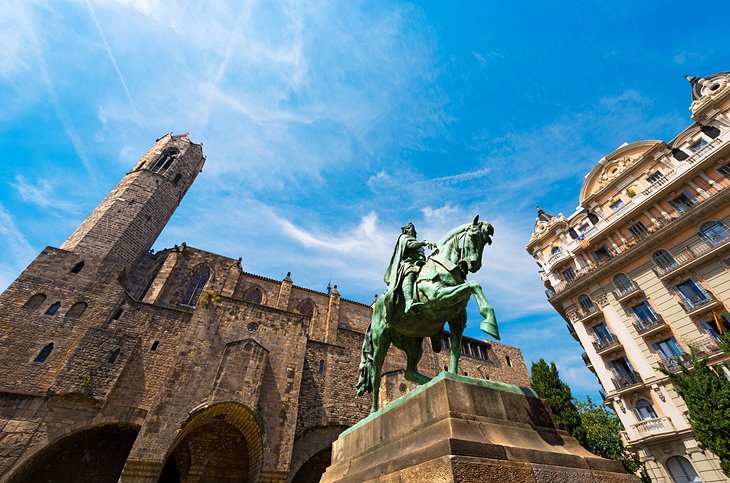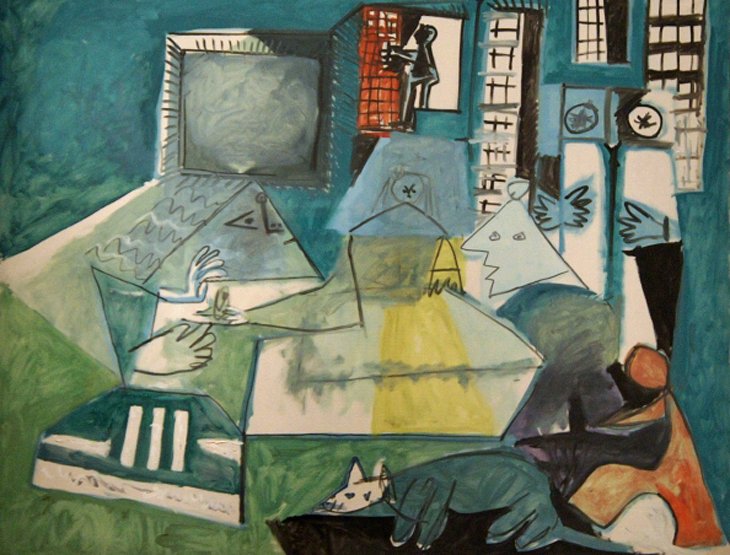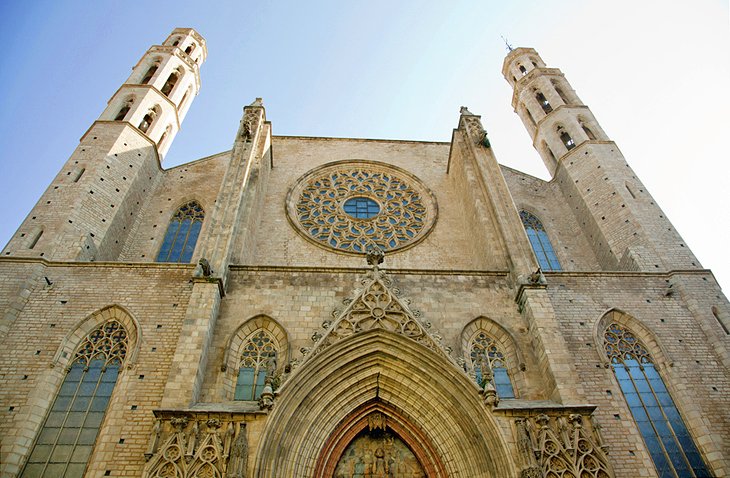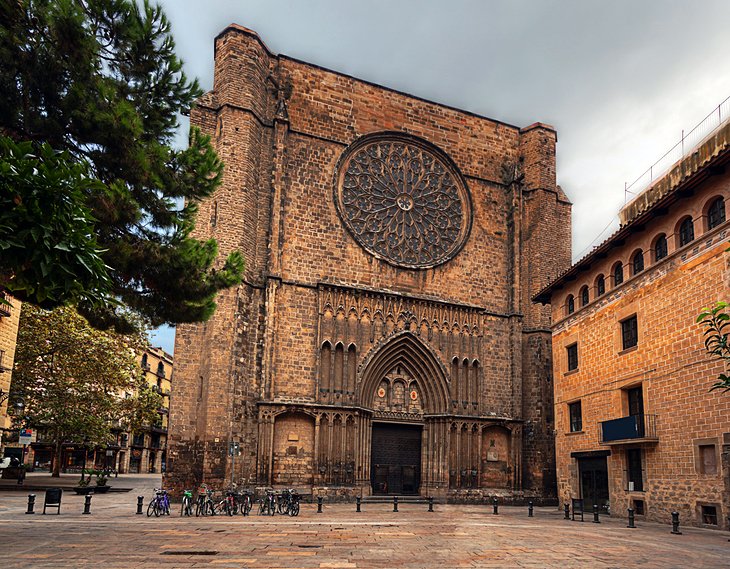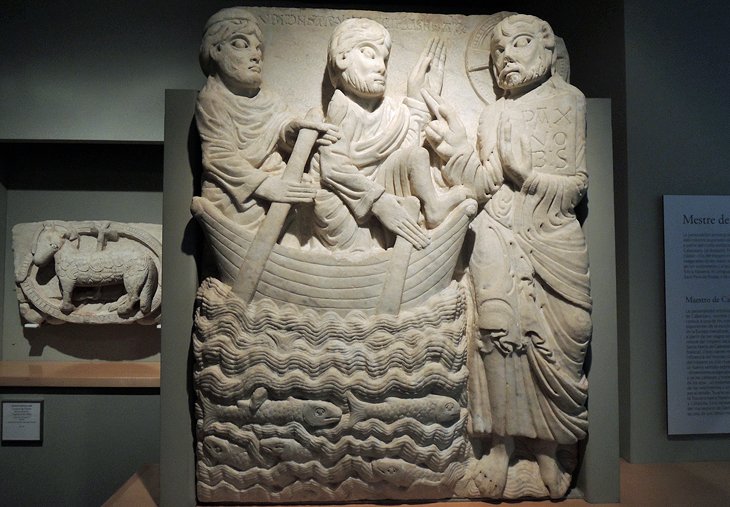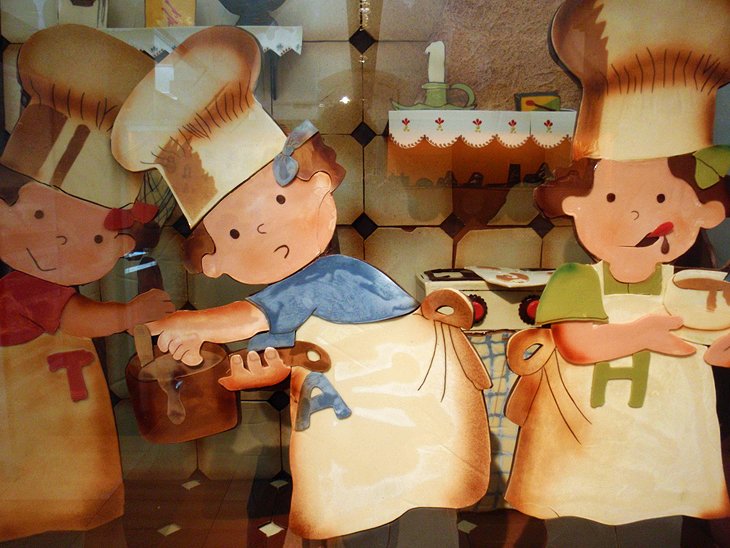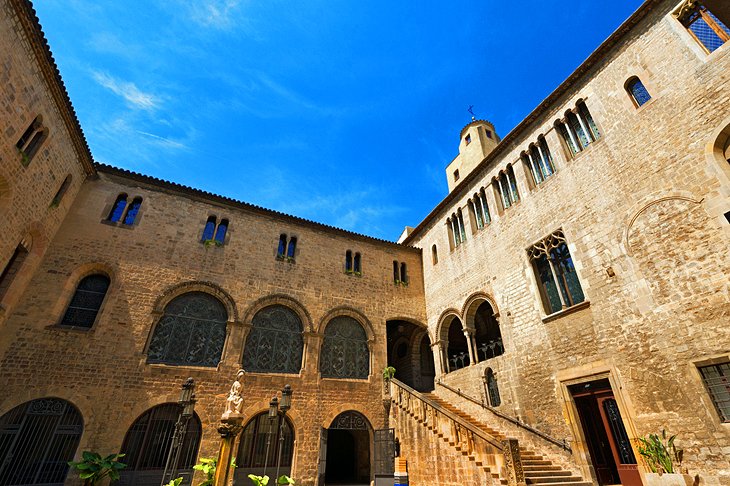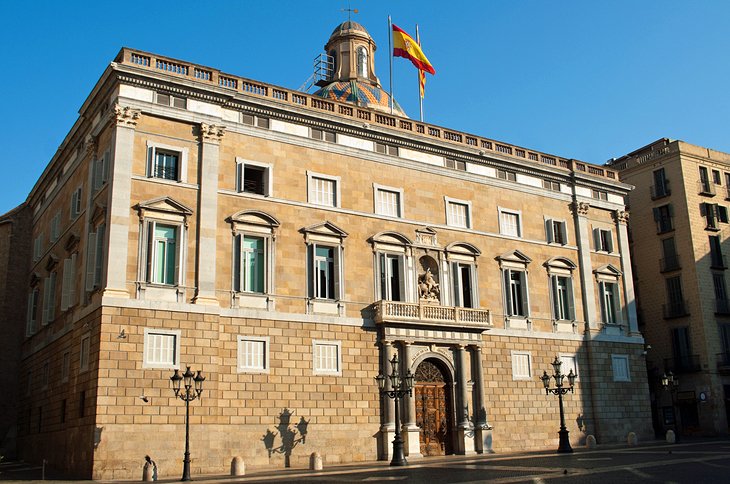
Barcelona, Blog, See & Do, Spain
Casa Mila “La Pedrera
A masterpiece by architecture Gaudí
Barcelona, Spain
Everything in this building is curved and undulating. Its originality and the techniques used in its construction are surprising throughout.
This is one of the best-known works of the architect Gaudí, and is one of the symbols of Barcelona. It was built between 1906 and 1912, and consists of a succession of stone walls on the outside, while the interior has two painted courtyards, columns and a range of rooms. There are large windows and iron balconies set into the undulating façade.

On the roof, meanwhile, there are chimneys and sculptures which are works of art in themselves, as well as a splendid view of the Paseo de Gràcia avenue. The building has been declared a World Heritage and is the pinnacle of Modernist techniques and tendencies.
History
In the year 1900, Passeig de Gràcia was the most important avenue in Barcelona. It was here that iconic buildings began to spring up, and the finest theatres and cinemas, and the most exclusive shops, restaurants and cafés opened.
It was also the boulevard on which the wealthiest and most ambitious members of the bourgeoisie decided to build their homes, vying with each other in a bold and exhibitionist manner by commissioning the most eminent architects of the day to undertake their projects.

In 1905, Pere Milà and Roser Segimon married. Attracted by the fame of Passeig de Gràcia, they purchased a detached house with garden situated on a plot measuring 1,835 square metres and they commissioned the architect Antoni Gaudi to build their new property.
The main floor of this new building, Casa Mila, was to be their home and they would rent out the other apartments.

There was considerable interest in the construction of Casa Mila and various reports about it were published, such as the piece in L’Edificació Moderna, magazine, the publication of the construction employers’ association.
The article stated that Gaudi was determined to meet the needs of modern life “without the nature of the materials or their resistance being an obstacle that limits his freedom of action”, and it described the structure of columns as an innovation that would result in large and well-lit spaces.
The construction of the building was complex and was fraught with financial and legal problems. Nor was it free from controversy. Gaudi kept changing his projects to shape the appearance of the structures of the building as the work advanced. He went well over the expected budget and did not abide by the City Council’s building codes: the built volume was illegal; the attic and the rooftop exceeded the permitted maximums; and one of the pillars of the façade occupied part of the pavement on Passeig de Gràcia.
When Gaudi discovered that an inspector had been by to alert the builder, Mr. Bayó, to these illegalities, he left very precise instructions. If the inspector came back and the column had to be cut, Gaudi would have a plaque put up, stating “the section of column that is missing was cut at the order of the City Council”.
After many years of neglect, Casa Mila, popularly known as La Pedrera and declared a World Heritage Site in 1984 by UNESCO, was restored and opened to the public in 1996.
Plan your visit
From Mar 01 to Nov 04
Monday to Sunday
9:00 AM to 8:30 PM
9:00 PM to 11:00 PM
From Nov 05 to Feb 28
Monday to Sunday
9:00 AM to 6:30 PM
7:00 PM to 9:00 PM
From Dec 26 to Jan 03
Monday to Sunday
9:00 AM to 8:30 PM
9:00 PM to 11:00 PM<
Prices
- General:€22
- Reduced:€16,50
- Children:€11
- Free entrance: children aged 0 to 6.
Services
Audio guide, Cafe, Guided tours
Contact details
Provença, 261 – 265
08008 Barcelona (Catalonia)
info@lapedrera.com
www.lapedrera.com/es/home
Tel.:+ 34 932142576

Barcelona, Blog, See & Do, Spain
12 Top-Rated Tourist Attractions of Barcelona’s Gothic Quarter
Known for its winding streets and hidden squares steeped in history, El Barri Gòtic is ideal for a historic walk followed by a rest at one of the many trendy bars or cafes.
A trip through this colorful neighborhood is a trip through time, as this old city center is still largely intact, retaining much of its labyrinthine medieval street plan, with a multitude of small streets opening into bustling squares.
Most of the quarter is closed to regular traffic, though service vehicles and taxis are allowed to pass through. Many of the landmark buildings located here date from the Middle Ages, with several sites harking back to the Roman times. El Cali, the medieval Jewish quarter, is also located within this area.
Brimming with Old World charm, the Barri Gòtic of Barcelona captures the ambience of centuries ago. This medieval quarter is a quaint, traffic-free world where almost every architectural detail seems frozen in the Middle Ages. Imposing Gothic buildings with magnificent facades have stood the test of time, and amazingly narrow pedestrian streets show the wear on their smoothed-down cobblestones. Anywhere one wanders, hidden surprises abound, from tiny arcaded alleyways to inviting patios with peaceful fountains. Street musicians find quiet courtyards where the acoustics are perfect for playing melodies of classical Spanish guitar. Many of the quarter’s little squares have pleasant outdoor cafés, and children often use the uncrowded plazas for impromptu football games. As if the atmosphere itself is not enough of a draw, the Gothic Quarter is packed with cultural attractions and fun things to do. Begin with the cathedral and then continue on a leisurely tour of the churches and museums, soaking up the history along the way.
1 Catedral de Santa Eulalia
This splendid Gothic cathedral stands on the highest point in the Gothic Quarter, surrounded by a delightful maze of narrow medieval lanes. The cathedral was constructed during the Romanesque period (13th century), but it was finished in the medieval era, and the exterior was renovated in the late 19th to early 20th centuries.
Admire the grandiose facade, adorned with an arched doorway and an abundance of spires and vertical buttresses. Step inside to be inspired by the bright and spacious sanctuary. The layout of the interior is unusual for a Gothic cathedral because it was built on the site of a Paleo-Christian basilica. Be sure to see the crypt with its ancient tombs and the museum in the Sala Capitular that displays paintings by Spanish masters from the 15th and 16th centuries. Other highlights include the cloister’s entrance door and the Chapel of Santa Lucía.
Address: Plaza de la Seu, Barcelona
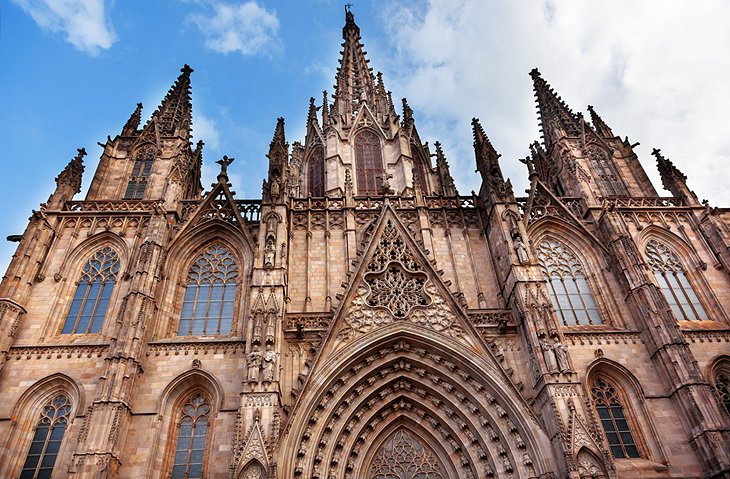
2 Plaça del Rei
The Plaça del Rei is one of the most beautiful squares in Barcelona’s old town. It is surrounded by impressive medieval buildings and opens up to the quarter’s narrow streets on its southern side. On the Plaça del Rei stands the Casa Clariana Padellás, a typical medieval urban palace. Important remains of the old Roman town were discovered when excavating for the foundations for rebuilding the palace. Since that discovery, the town decided to house the Historical Museum in the building. The basement of the museum reveals the archaeological site. Visitors will see fascinating Roman ruins, including parts of a heating system, mosaic floors, remnants of surrounding walls, and the water and drainage systems. The rest of the museum is devoted to historical paintings and the Galeria de Catalans, which presents the work of famous historical figures and artists of the Catalonia region.
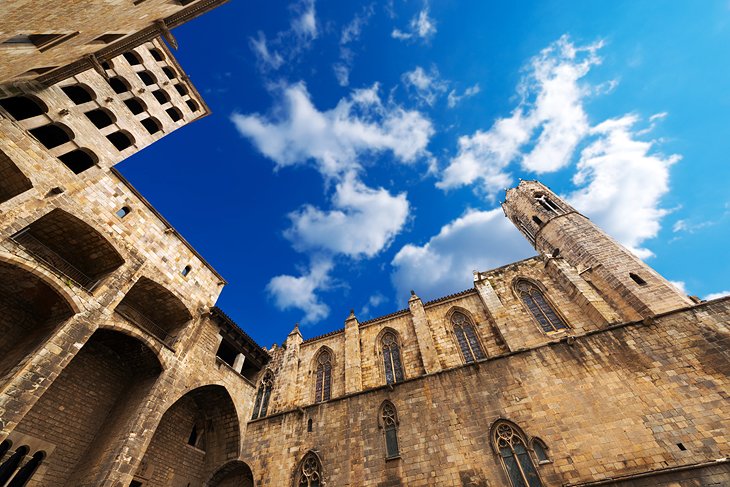
3 Cappella di Santa Agata
Built in the 14th century on the site of the old Roman town wall, this Gothic chapel was once the chapel of the Palazzo Reale Maggiore (Royal Palace). The chapel is renowned for the Altare del Connestabile (altarpiece) by Jaume Huguet, which is considered among the finest works of Catalan painting. Also notice the windows in the choir and gallery, which show the various coats-of-arms of the counts of Barcelona. The sacristy contains an interesting iron mechanical clock dating from 1576. A small room in the chapel leads up to the 17th-century tower of Martín el Humano (Martin the Humanist). The chapel is no longer used for religious services, but the monument is open to the public for visits.
Address: Plaza del Rey, Barcelona
4 Museu Picasso
The Picasso Museum is on one of the most atmospheric streets in the Gothic Quarter. The museum occupies the Palau Berenguer d’Aguilar, an impressive Late Gothic palace with grandiose halls and a charming inner courtyard. The museum’s exhibits are arranged in chronological order, showing the different phases of Pablo Picasso’s artistic development. This extensive collection includes paintings and drawings as well as prints (lithographs and etchings) from all of Picasso’s artistic periods, and is the largest collection anywhere of his early works. Highlights of the museum include the Cubist paintings, the enormous painting of Ciéncia y Caridad (Science and Charity), and Los Pichones (The Doves).
Address: 15 – 23 Carrer Montcada, Barcelona
5 Iglesia de Santa Maria del Mar
Near the Picasso Museum, the 14th-century Iglesia de Santa Maria del Mar is a stunning Gothic church. Take time to admire the richly decorated facade, especially the main doorway. Illuminated by a splendid rose window and other stained-glass windows, the sumptuous interior gives a harmonious impression of space. After the cathedral, this church is considered the most important religious building in the city. A precious icon of a Black Madonna is found in the chapel near the left side door.
Address: Plaza de Santa María, Barcelona
6 Iglesia de Santa Maria del Pí
The striking Gothic church of Santa Maria del Pí (Blessed Lady of the Pine Tree) features an austere fortress-like facade. The only adornment on the exterior is the pointed-arch doorway featuring a statue of the Madonna and a large rose window. The simple single-aisled interior is flanked by chapels and illuminated by 15th- to 18th-century stained-glass windows. Near the door to the sacristy is the 14th-century tomb of Arnau Ferre, who died at the Siege of Catania in Sicily. The treasury contains a noteworthy collection of sacred art as well as goldsmith and silversmith work.
Address: Plaza del Pí, Barcelona
7 Museu Frederic Marès
Tucked away in a quiet square of the Gothic Quarter, this museum is a hidden treasure. The museum occupies a beautiful space in the marvelous Salò del Tinell reception hall that was part of the 12th-century Palau Reial Major (Royal Palace). On display is the private collection donated by sculptor Frederic Marès Deulovol to the city. The collection includes ancient Roman sculptures as well as Romanesque and Gothic religious art and Baroque decorative objects. To arrive at the museum, walk through the archway from the Carrer dels Comtes de Barcelona, which leads into a picturesque inner courtyard.
Address: 5 – 6 Plaça Sant Iu, Barcelona
8 Museu de la Xocolata
Barcelona Confectioners’ Guild created the Museum of Chocolate in the year 2000. This delightful museum is housed in the former Convent of Sant Agustí, an exquisite historic building with a lovely Gothic cloister. The museum discusses the history and art of chocolate. Visitors learn about the discovery of the cocoa bean by New World explorers, the commerce of chocolate, and chocolate as an art form.
Address: Carrer del Comerç, 36, 08003 Barcelona
9 Museu del Calçat (Museum of Shoemaking)
This tiny museum has one of the most unique collections in Barcelona, entirely dedicated to the craft of shoemaking. The museum is housed in the Renaissance building, which belonged to the medieval Guild of Master Shoemakers. The museum traces the historical development of shoes and shoemaking in Catalonia. Exhibits display antique shoes and tools used in the trade. A highlight of the collection is the display of shoes worn by famous people.
Address: Plaza Sant Felip Neri, Barcelona
10 Palau Episcopal
Adjoining the cathedral on the west side, the Episcopal Palace was founded in the 10th century. The present building dates from the 12th and 13th centuries but incorporates architectural elements from Roman times – the two round towers on the Portal del Bisbe. In the 15th century, the building was enhanced, and in the 19th century, it was renovated. The splendid inner courtyard is occasionally open to tourists. This area features a Romanesque arcaded gallery and contains a modern statue of Our Lady of Montserrat.
Address: 5 Calle del Bisbe, Barcelona
11 Museu d’Holografia
Barcelona’s Holographic Museum is the first of its kind in Spain. The small museum, resembling a gallery, is dedicated to the art of holography – works created using three-dimensional pattern-producing techniques that originated with the development of lasers. According to the position of the observer and the angle at which the light falls, the hologram presents different images. When the observer moves, there is the illusion that the artwork has magically transformed. The most striking feature of the museum is the hologram on the first floor, a design of spirals and flowers, which is truly breathtaking. To find the Holographic Museum, walk to the Carrer de Jaume by way of the Plaça Sant Jaume.
Address: 1 Carrer de Jaume I, Barcelona
12 Palau de la Generalitat
On the northwestern side of the Plaça de Sant Jaume, the Palau de la Generalitat is a relatively modern building for the Gothic Quarter. Built in the 15th century, this medieval palace was once the seat of the provincial representatives. Today, the building houses the Generalitat de Catalunya, the autonomous government of Catalonia.
Address: 4 Plaza de Sant Jaume, Barcelona








